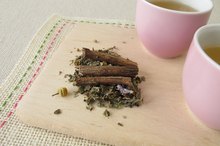What does fact checked mean?
At Healthfully, we strive to deliver objective content that is accurate and up-to-date. Our team periodically reviews articles in order to ensure content quality. The sources cited below consist of evidence from peer-reviewed journals, prominent medical organizations, academic associations, and government data.
- National Digestive Diseases Information Clearinghouse: Constipation
- MedlinePlus: Soluble vs Insoluble Fiber
- Linus Pauling Institute: Fiber
The information contained on this site is for informational purposes only, and should not be used as a substitute for the advice of a professional health care provider. Please check with the appropriate physician regarding health questions and concerns. Although we strive to deliver accurate and up-to-date information, no guarantee to that effect is made.
Will Wheat Germ Help With Constipation?
Wheat germ will help with constipation because it is considered a high-fiber food 1. The use of wheat germ -- an ingredient found in cereal and breads, as well as other baked goods -- to treat constipation should only be implemented while under the direction of your doctor 1. Do not use wheat germ or any other food-related supplement to treat a medical condition without the advice of a health care profession 1. Wheat germ is not for everyone 1. People with certain conditions, such as Celiac disease and a wheat allergy, should not consume wheat germ 1.
Constipation
Constipation is defined by Brown University as passing fewer than three stools a week 2. The main cause of constipation is a low-fiber diet, but may also be the result of digestive conditions and certain medications. If you’re constipated you will develop hard stools that cause you to strain, the feeling of an incomplete bowel movement and a sense that your rectum is blocked. Constipation may be a sign of a more serious condition.
- Constipation is defined by Brown University as passing fewer than three stools a week 2.
- Constipation may be a sign of a more serious condition.
Wheat Germ
Licorice Root for Constipation
Learn More
Wheat germ is a common ingredient in backed goods and may be sold as a dietary supplement 1. Wheat germ is considered the most nutritious part of the wheat berry and has a very nutty flavor, according to Food.com 1. Germ is commonly removed from the rest of the berry during the milling process. According to Harvard University Health Services, wheat germ contains 3.9 grams of dietary fiber per 3 tablespoon serving -- a significant portion of the 26 to 38 grams recommended daily 1. Each serving contains 0.7 gram of soluble fiber and 3.2 grams of insoluble fiber 3. One of the most common ways to treat and prevent constipation is to increase your daily fiber intake, according to the National Digestive Diseases Information Clearinghouse.
Two Types of Fiber
Fiber is the portion of plant foods that is not digested by the body, causing digestive health and can help lower the risk of heart disease, according to MedlinePlus 3. Wheat germ primarily contains soluble fiber, the type of fiber that does not absorb water in the digestive tract 1. Soluble fiber slows down digestion but at the same time makes your stool softer and easier to pass. Insoluble fiber swells when it enters your digestive system, pulling water from the intestines, causing greater bulk to be added to your stool. Increasing both types of fiber can help regulate your bowels.
- Fiber is the portion of plant foods that is not digested by the body, causing digestive health and can help lower the risk of heart disease, according to MedlinePlus 3.
- Insoluble fiber swells when it enters your digestive system, pulling water from the intestines, causing greater bulk to be added to your stool.
Serving Tips and Consideration
Wheat Dextrin & Fiber
Learn More
Sprinkle wheat germ over your favorite cold cereal, cook it into your oatmeal or add it to yogurt for a healthful snack 1. Alternatively, add wheat germ to whole-grain muffins for a convenient on-the-go snack, or add it to homemade granola 1.
If you’re unable to consume wheat germ, you may be able to use other fiber supplements made from psyllium husk or inulin fiber 1. These fiber supplements are wheat and gluten-free. Discontinue the use of any supplement if you develop adverse reactions.
- Sprinkle wheat germ over your favorite cold cereal, cook it into your oatmeal or add it to yogurt for a healthful snack 1.
- If you’re unable to consume wheat germ, you may be able to use other fiber supplements made from psyllium husk or inulin fiber 1.
Related Articles
References
- Food.com: Wheat Germ
- Brown University: Constipation
- MedlinePlus: Soluble vs Insoluble Fiber
- Linus Pauling Institute: Fiber
- Schagen SK, Zampeli VA, Makrantonaki E, Zouboulis CC. Discovering the link between nutrition and skin aging. Dermatoendocrinol. 2012;4(3):298-307. doi:10.4161/derm.22876
- National Institutes of Health. Vitamin E: Fact Sheet for Health Professionals. Updated February 28, 2020.
- Keen MA, Hassan I. Vitamin E in dermatology. Indian Dermatol Online J. 2016;7(4):311-5. doi:10.4103/2229-5178.185494
- Food Allergy Research & Education. Wheat Allergy.
- Berkeley Wellness. University of California. Should Anyone Take Vitamin E?. Published January 24, 2014.
Writer Bio
Diane Marks started her writing career in 2010 and has been in health care administration for more than 30 years. She holds a registered nurse license from Citizens General Hospital School of Nursing, a Bachelor of Arts in health care education from California University of Pennsylvania and a Master of Science in health administration from the University of Pittsburgh.









